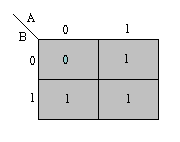Ask any child what “1 + 1” is, and without hesitation you’d get the answer “2”. Likewise, an adult will most definitely respond with the same. But if you think deeper, there are other answers that would be correct as well, depending on the person’s perspective.
Here, I will show you ten answers to this seemingly innocent question. Three of them are actually so-called “standard” jokes you’d find on the ‘Net regarding lawyers, accountants and mathematicians. Six more are my own interpretation.
Let’s have a look and see which ones really get you…
Question: What is 1 + 1?
Child: “Simple; it’s 2.” [Ya, you know this already]
———-
Accountant: “I think it’s either 2 or 3. Let me run those figures through my spreadsheet one more time.”
Lawyer, in a hushed voice: “How much do you want it to be?”
[This is after the lawyer has pulled the drapes, locked the door and dimmed the lights…]
Mathematician: “It looks like the answer should converge to 2.”
———-
Chip designer: “1 + 1 = 1. My Karnaugh Map says so.” [see pix below]

Chip designers learn about Boolean algebra and use Karnaugh Maps (or K-maps) as a tool to minimize Boolean expressions. The “+” operator represents the OR function, such that 1 OR 1 is 1. You can find an intro to K-maps here.
Maths student, having just learned about the binary system: “1 + 1 = 10.”
In case you are new to binary, there are only 2 digits — 0 and 1 — in this system. So, binary 10 is actually 1 x 21 + 0 x 20, or 2 in the decimal world.
Chinese calligrapher: “![]() … (lemme see…)
… (lemme see…) ![]() +
+ ![]() =
= ![]() .”
.”
This is exactly how ![]() (the Chinese character for king) is written, stroke by stroke, starting with the top horizontal line, followed by the “plus” and finally the bottom line.
(the Chinese character for king) is written, stroke by stroke, starting with the top horizontal line, followed by the “plus” and finally the bottom line.
Pregnant lady: “Just look at me!”
Student leader, tallying results of an opinion poll: “I + I = II.”
Tallying is a form of counting that dates back to ancient times. It is a way of recording intermediate counts by building on previous results — the diagram below depicts how a count of 1 to 5 is recorded with tally marks. Learn more about tally marks at Wikipedia.
Tally marks showing how to record 1 to 5 counts (from left to right, respectively). This is the tally system used in North America.
Singaporean diner, accompanied by a friend: “It’s a good deal, what.”
In the local context, “1 + 1” can mean a 1-for-1 offer, where another (lower-priced) meal can be had for free with each paid order. Thus, two persons can dine together for the price of one.
There you go, 10 different answers to the simple “1 + 1” question. Some are plainly obvious, some not so; and then there are those that are just WittyCulus.
Perhaps you have yet another view on this. Feel free to comment on this post and share your version of the answer.





![Go on a journey to learn Bob [The Secret] Proctor's other secrets... 11 Forgotten Laws button ad](http://www.the11forgottenlaws.com/project/media/images/affiliates/banners/250-250a-v2.jpg)

